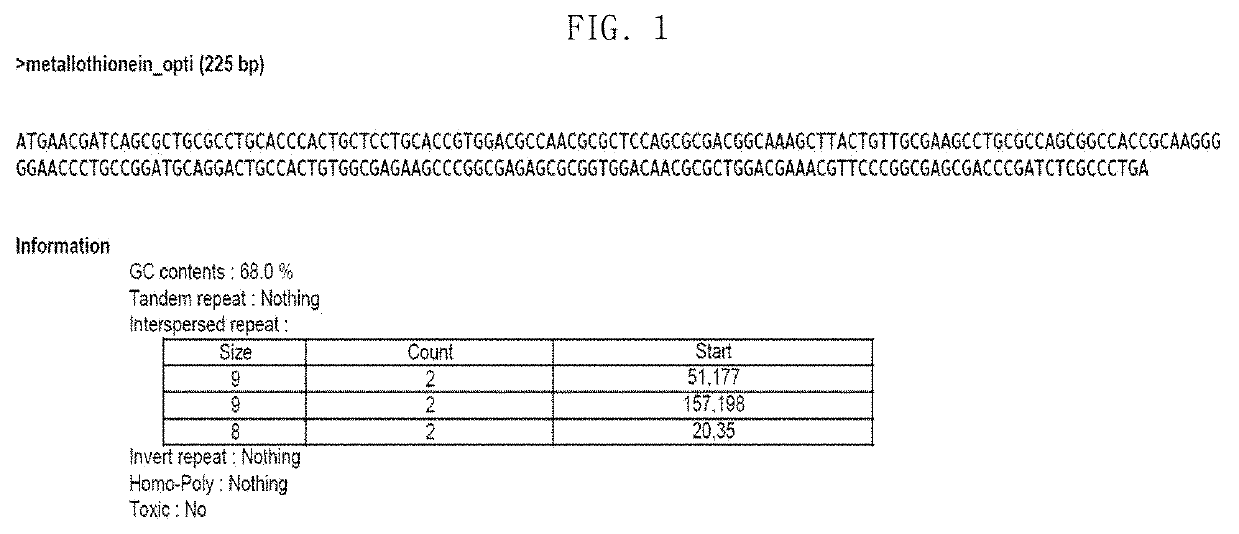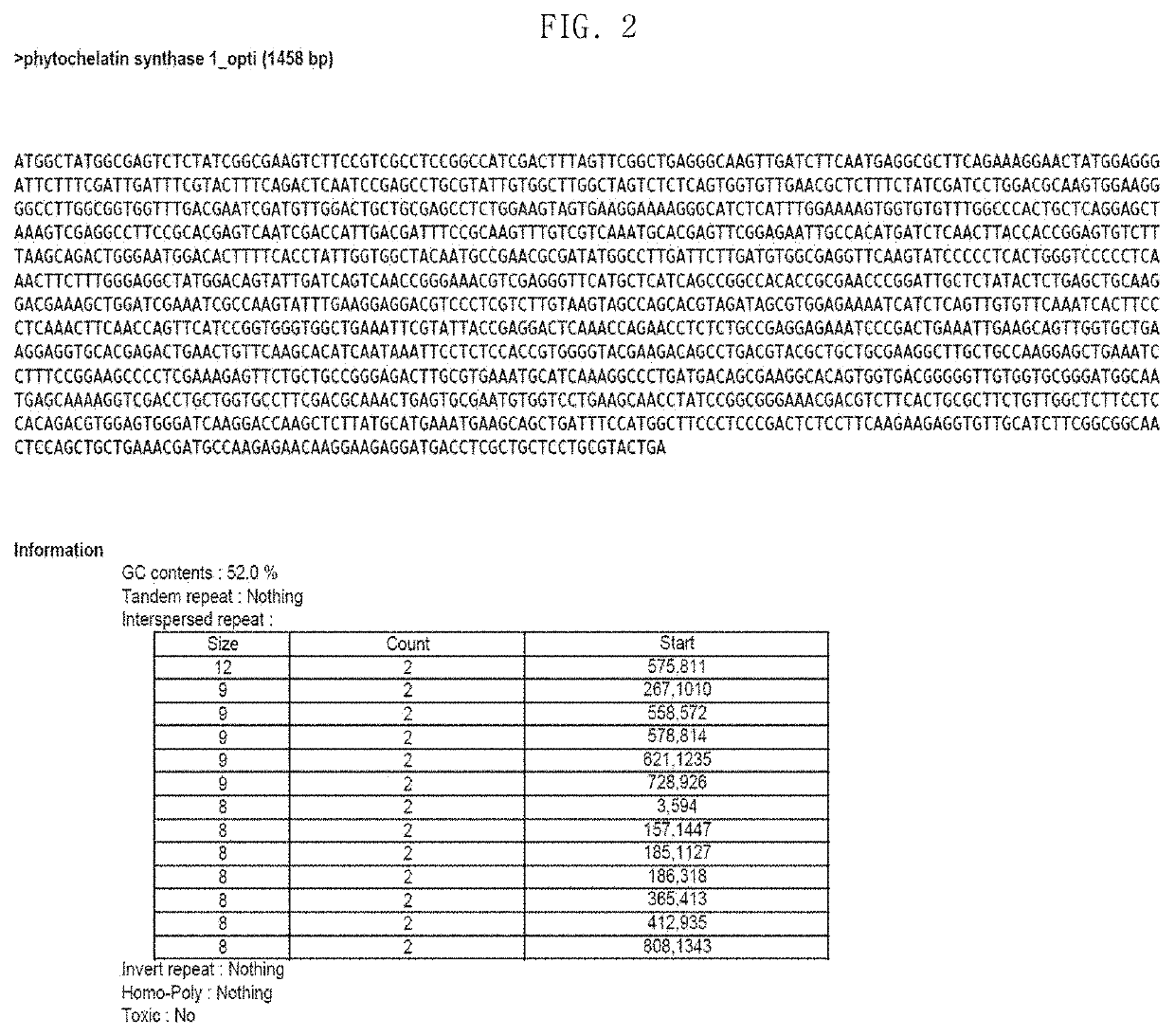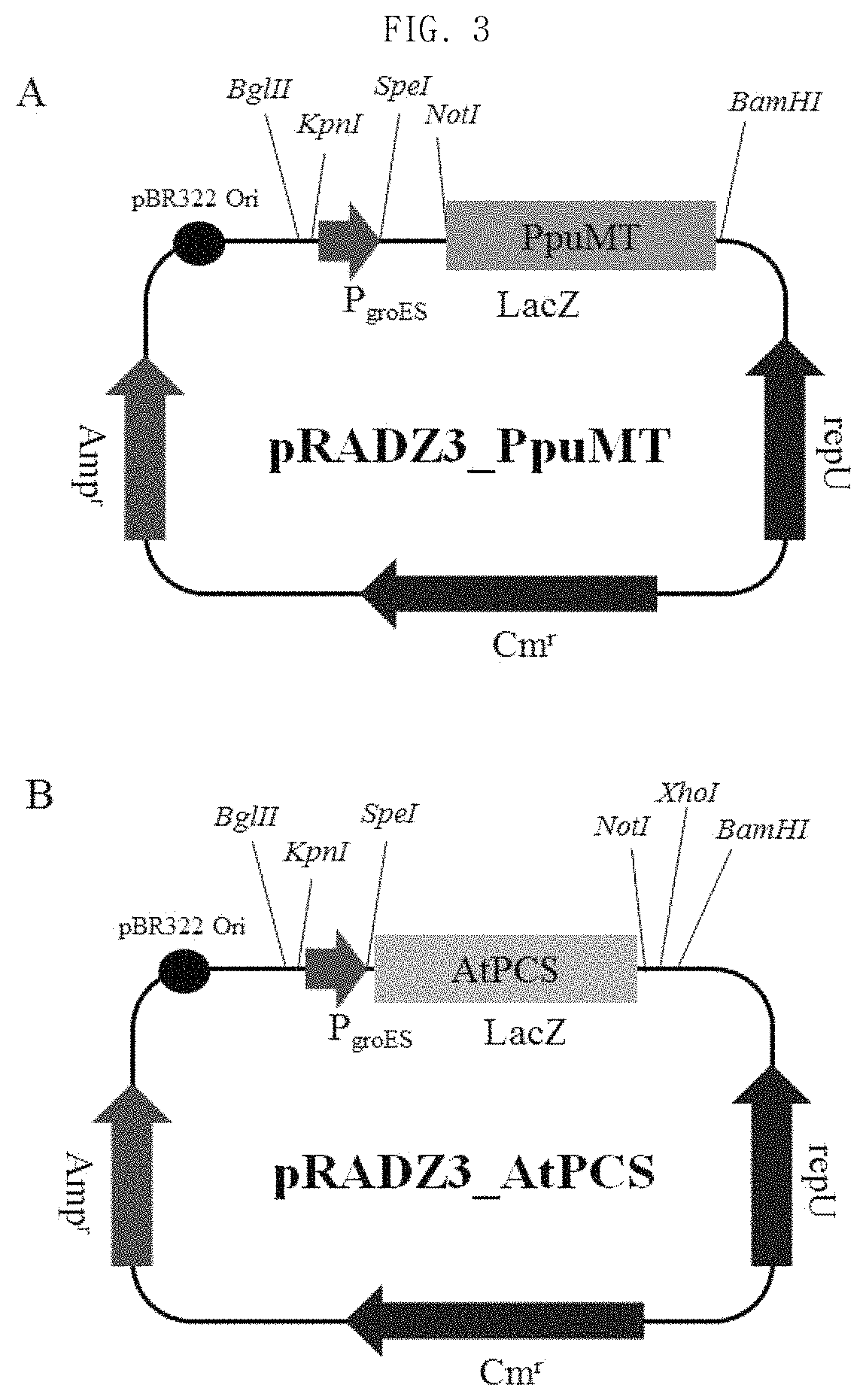Deinococcus radiodurans having gold nanoparticle synthesis ability, and method for removing radioactive iodine by using same
a technology of radioactive iodine and nanoparticles, which is applied in the direction of peptides, transferases, peptide sources, etc., can solve the problems of low removal efficiency of radioactive iodine, insufficient research on selective removal methods and apparatuses, and continuous generation of new solid radioactive was
- Summary
- Abstract
- Description
- Claims
- Application Information
AI Technical Summary
Benefits of technology
Problems solved by technology
Method used
Image
Examples
example 1
Construction of Recombinant Vector Containing Codon-Optimized Gene
[0053]1-1: Construction of Expression Vector for Metallothionein
[0054]A nucleotide sequence of SEQ ID NO: 1 was synthesized by codon-optimizing a gene (PpuMT) encoding metallothionein of Pseudomonas putida KT2440 for Deinococcus radiodurans. Then, polymerase chain reaction (PCR) was performed using primers of SEQ ID NO: 3 (GroMT_3) and SEQ ID NO: 4 (GroMT_4) using the codon-optimized PpuMT as a template.
[0055]
(GroMT_3):SEQ ID NO: 3ggcggccgttactagtggatatgaacgatcagcgctgcgc(GroMT_4):SEQ ID NO: 4TATTGGATCCTCAGGGCGAGATCGGGTCGC
[0056]Meanwhile, the pRADZ3 plasmid was digested with NotI and BamHI restriction enzymes, and then pRADZ3 cut by gel extraction was isolated. At the same time, a GroES promoter was amplified by PCR using the pRADZ3 plasmid as a template and the primers of SEQ ID NO: 5 (GroMT_1) and SEQ ID NO: 6 (GroMT_2).
[0057]
(GroMT_1):SEQ ID NO: 5TATTGCGGCCGCTTGGAAGCACGTATTGTCGC(GroMT_2):SEQ ID NO: 6gcgcagcgctgatcgt...
example 2
Production of Deinococcus Radiodurans Having Gold Nanoparticle Synthesis Ability
[0064]2-1: Production of Microorganisms for Radioactive Iodine Removal
[0065]The pPADM3 plasmid constructed according to Example 1 into which PpuMT or AtPCS was inserted was transformed into Deinococcus radiodurans R1 ATCC13939, and E. coli was used as a control.
[0066]The transformed microorganism was pre-cultured in 5 ml of a liquid medium containing TGY (Tryptone 0.5%, glucose 0.1%, yeast extract 0.3%) and 3 μg / ml of chloramphenicol, 50 ml of fresh TGY was added to a 250 ml flask and subjected to dilution to a final O.D. of 0.1, and then the microorganism was cultured at 30° C. and 200 rpm up to O.D. 1. Thereafter, a gold (III) chloride hydrate solution was added to the culture solution to a final concentration of 1.25 mM, and further cultured for 16 hours (overnight) to synthesize gold nanoparticles in the cells of Deinococcus radiodurans.
[0067]The Deinococcus radiodurans culture solution, in which th...
example 3
Removal of Radioactive Iodine Using Deinococcus Radiodurans
[0072]3-1: Deinococcus Radiodurans Having Gold Nanoparticle Synthesis Ability
[0073]1 ml of Deinococcus radiodurans prepared according to Example 2 into which AtPCS or PpuMT was introduced was added to 5 ml of DW containing 100 μCi [125I] NaI under the condition of 1.25 mM Au3+ and incubated at room temperature, and iodine removal efficacy thereof was analyzed by Radio-TLC over time (See FIGS. 6 and 7). As a control, iodine removal efficacy was analyzed using E. coli under the same conditions.
[0074]As a result, it was confirmed that Deinococcus radiodurans had a radioactive iodine removing ability even when AtPCS or PpuMT was not introduced thereinto (See FIG. 6).
[0075]Thus, enhanced radioactive iodine removal ability of the Deinococcus radiodurans into which the codon-optimized AtPCS or PpuMT was introduced was confirmed.
[0076]As a result, the PpuMT-introduced Deinococcus radiodurans exhibited a remarkably great radioactive...
PUM
| Property | Measurement | Unit |
|---|---|---|
| particle diameter | aaaaa | aaaaa |
| particle diameter | aaaaa | aaaaa |
| radioactive iodine removal ability | aaaaa | aaaaa |
Abstract
Description
Claims
Application Information
 Login to View More
Login to View More - R&D
- Intellectual Property
- Life Sciences
- Materials
- Tech Scout
- Unparalleled Data Quality
- Higher Quality Content
- 60% Fewer Hallucinations
Browse by: Latest US Patents, China's latest patents, Technical Efficacy Thesaurus, Application Domain, Technology Topic, Popular Technical Reports.
© 2025 PatSnap. All rights reserved.Legal|Privacy policy|Modern Slavery Act Transparency Statement|Sitemap|About US| Contact US: help@patsnap.com



